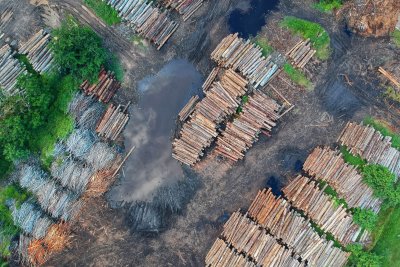Could a supreme court ruling mean the beginning of the end for polluting factory farming?
Council planning teams must fully consider greenhouse gas emissions - both ‘direct’ and ‘indirect’ - when making planning decisions, according to a recent court ruling. The case in question relates to Surrey County Council and an application for an oil well. But with greenhouse gas assessments normally missing from intensive livestock planning applications, we chew over what this landmark decision could mean for the future of factory farming.

What is the problem?
Despite the known animal cruelty, pollution and human exploitation caused by industrial-scale indoor animal agriculture, the number of intensive livestock units (those with over 40,000 places for chickens, 2,000 places for production pigs or 750 places for sows) is on the rise - increasing by 12% between 2016 and 2023.
Agribusinesses have been limiting the disclosure of information around emissions...thwarting the informed, inclusive and democratic process that the public are entitled to
To build a new intensive livestock unit, or significantly enlarge an existing one, planning permission must be granted by the local planning authority. Having sifted through a number of the applications placed in front of councils, it’s clear that indirect emissions aren’t being considered. Offsite emissions include things such as emissions associated with feed production, as feed for intensive farms is grown elsewhere and often imported to the UK.
This case might change all that. It was brought by local campaigner Sarah Finch, who argued that the environmental impact assessment conducted as part of the planning application should have considered indirect ‘scope 3’ emissions. The court agreed. They ruled that indirect emissions are within the scope of the Environmental Impact Assessment (EIA) required by law. They judged that the council’s failure to assess indirect emissions (in this case the effect of the combustion of the oil produced from the proposed oil well) means that its decision to grant planning permission was unlawful.
What are Environmental Impact Assessments (EIAs) and why are they important?
In the UK, any development that is likely to have a significant effect on the environment needs an EIA. These must identify, describe and assess the likely “direct and indirect significant effects” of the project on the environment, including (among other factors) the impact on climate (for example, the nature and magnitude of greenhouse gas emissions). Councils must take EIA into account when making a decision.
The judges emphasised that EIAs are there to ensure that decisions are taken with full public knowledge of the likely environmental consequences. They aim to ensure that if consent is given, it is with full knowledge of the environmental cost. They describe it as ‘essential to the validity of the decision’ that there has been a comprehensive assessment, as part of an inclusive and democratic procedure (see paragraph 62).
What are indirect impacts and ‘scope 3’ emissions?
The judgement contained a useful summary of common terminology around the direct and indirect emissions they deem relevant to the EIA. They accepted the Greenhouse Gas Protocol Corporate Accounting and Reporting Standard (the “Protocol”) as a respected definition of emissions scope terminology. The Protocol classifies Scope 1 emissions as direct emissions from the building, which for factory farming includes ‘enteric’ emissions from animals’ digestion and faeces. Scope 2 emissions are indirect emissions related to the units themselves, including emissions from energy used to heat units. Scope 3 activities include the extraction and production of raw materials, transportation of sold products, management of waste and use of sold products and services.
Geographical limits
The judgement discussed geographical scope. The EIA Directive does not impose any geographical limit on the scope of the environmental effects and the judges said the council was wrong to confine the EIA to emissions at the project site, saying it is in the very nature of “indirect” effects that they may occur away from their source. Moreover, the impact of greenhouse gas emissions on climate does not depend on where the release occurs.
Councils need to ensure that full, comprehensive assessments of direct and indirect impacts (ie greenhouse gas emissions and waste) are undertaken for intensive livestock applications.
What could this mean for intensive livestock applications?
Having leafed through a regrettably large number of planning applications for intensive livestock units, it’s clear that developers go to significant lengths to avoid talking about the vast greenhouse gas emissions from livestock units. They present the large corrugated metal units as environmentally responsible. They are described as modern, high-tech, efficient, and even ‘low-emissions’. Typically, applications don’t include a GHG assessment as part of the planning application. Where GHGs are referred to, this is normally a few short sentences for example the use of renewable energy in units.
Indirect emissions in intensive livestock agriculture
The greenhouse gas emissions for an intensive livestock unit are very significant. Sustain estimates the annual GHG emissions from a chicken shed with 20,000 capacity to be 2,058 tonnes CO2 equivalent. For pigs, estimated annual emissions from a unit with 2,000 capacity is 2,708 T CO2e (calculations below). By comparison, York council estimates that switching their entire bus fleet to electric saves 3,000 T CO2e annually. Indirect ‘scope 3’ emissions in intensive animal agriculture are thought to account for at least 90% of emissions. Avara Foods, one of the largest chicken agribusinesses in the UK, estimates their scope 3 emissions to be about 95%. According to FAIRR, Scope 3 makes up 96% of pork giant Cranswick’s emissions. These emissions chiefly come from feed, which accounts for an estimated 75% of impacts from a chicken. Animal feed uses a colossal 40% of the UK's arable land area, half our annual wheat harvest and a third of our oat harvest. Soy fed to UK livestock uses 850,000ha of land abroad, and drives deforestation and land conversion.
Why developers should provide information about the impacts of the proposal
There is no element of conjecture about the need for large quantities of feed for animals, and there is clear causation. You can’t produce animals without feeding them. Agribusinesses have essentially been limiting the disclosure of information around emissions in impact assessments, mentioning only very direct emissions - if any - and therefore pushing through planning applications on the basis of declaring a fraction of the climate impact. This is clearly far from a ‘comprehensive’ assessment. The purpose of EIAs is to enable public participation in environmental decision making. Where the full impact of intensive livestock units is being kept from the public, it is thwarting the informed, inclusive and democratic process that the public are entitled to.
Were these indirect emissions included in an impact assessment, councils and the public could scrutinise how the applications compare to their climate strategies. There are also moral considerations that relate to indirect emissions, such as how a development may impact global deforestation and lives of those displaced by land clearing. People care about issues beyond their geographical borders and they should be armed with information to make decisions about these issues.
By means of illustration, an application for one of the largest factory farms in Europe is currently on the table of King’s Lynn and West Norfolk District Council. Its impact assessment says the following about climate change:
The Proposed Development will be built to the appropriate regulatory standards, such as climate change and environmental performance standards…
…The need for a stand-alone greenhouse gas emissions assessment is not required. Climate change will, therefore, be scoped out of the EIA (see page 15 here)
As outlined in the letter Sustain submitted to the council, the emissions from this development would be colossal. It is proposing to produce more than six million chickens and fifty thousand pigs per year. A rough estimate suggests the likely GHG emissions will be hundreds of thousands of tonnes per year. A full assessment is needed to provide proper transparency to residents and planning decision makers. This can only be done by the developer as they hold information about the exact manner in which they propose the development will operate.
Downstream v upstream impacts
It’s true that technically this judgement ruled on ‘downstream’ effects, i.e. the use of the final product, rather than ‘upstream’ impacts from raw materials. In intensive agriculture many of the significant impacts occur upstream. However, every judgement will be made in relation to the factual matrix in that particular case - which in this instance was a development that had significant downstream impacts and no upstream effects. But the value of case law is the general principles they establish and here the judges emphasised that causation is the key factor. They said: The emissions that will occur on combustion of the oil produced are “effects of the project” because there is an evident causal connection between the extraction of the oil and its subsequent combustion. They said it doesn't matter how many intermediate steps there are - a direct causal link exists between the oil extraction and the combustion.
In essence we consider that the judgement supports the principle that the concern is the total environmental impacts of a development. It should not matter whether this is upstream or downstream.
Additionally, given that climate change is an international issue and emissions have a global impact, it would make no sense if consideration of an environmental impact was limited to only those activities that occurred within a particular geographical area or in relation to a particular process (i.e. only downstream processes). Omitting overseas impacts would also encourage intensive livestock producers to import feed from places that don't have robust environmental controls (such as Brazil) to avoid scrutiny. This would be entirely antithetical to what the EIA and the Aarhus convention are seeking to achieve.
What if the impact is covered by another regulation?
The judgement made an interesting point about whether pollution that is regulated by other, non-planning regimes needed to be included in an EIA. Can’t the council “assume that these regimes will operate effectively to avoid or mitigate the scope for material environmental harm”?.
This is relevant to intensive livestock farming because it produces significant amounts of waste, often spread on land locally, causing air and water pollution and odour and dust nuisance. This is theoretically covered by the Environment Agency as part of an environmental permit, and therefore EIAs have been found not to include a comprehensive and detailed assessment of what will happen to this waste. The judge ruled that the existence of other regimes does not remove the obligation to assess the impact of such waste in the EIA, emphasising again the need to report likely impacts to the public for scrutiny.
What next?
Councils have been making decisions about planning applications for intensive livestock units based on incomplete or nonexistent assessments of the climate impact. This case ruled that the council’s failure to fully assess emissions meant that the decision to grant planning permission was unlawful. Councils need to ensure that full, comprehensive assessments of both direct and indirect impacts (ie greenhouse gas emissions and waste) are undertaken for intensive livestock applications. This can be ensured by including text in the local plan, or introducing supplementary planning policy, to set out clearly what is expected of developers.
Check out Planning for the Planet where we have the resources for councils to do so.
Calculations for the GHG emissions from intensive chickens, pigs and dairy cows:
Chickens:
Each broiler chicken produces about 1.5kg edible meat and each kg meat causes 9.8kg CO2e
Chicken sheds typically contain 20,000 birds and produce 7 cycles per year, which is 140,000 birds per year.
The annual GHG emissions from one chicken shed therefore = (1.5 x 9.8) x 140,000 = 2,058 T CO2 equivalent
Pigs:
Each pig produces about 55kg edible meat = (62% yield from 88kg carcasse), each kg pig meat emits 12.31kg CO2e, and reach slaughter weight in 24 weeks, allowing 2 cycles per year.
A shed of 2000 pigs emits an estimated (55 x 12.31) x 2000 x 2 = 2,708 T CO2e
Published Tuesday 16 July 2024
Food for the Planet: Food for the Planet is helping local authorities, businesses and organisations take simple actions to tackle the climate and nature emergency through food.





